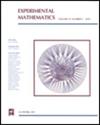广义5属曲线的θ超平面有效重构
IF 0.9
4区 数学
Q2 MATHEMATICS
引用次数: 0
摘要
摘要利用超平面有效地重构了5属曲线C的包络二次集;对于一般的5属曲线C,这些数据足以有效地重建C。因此,我们得到了5属曲线上的肖特基轨迹在超平面上的完整描述。证明的计算部分是一个证明的数值论证。本文章由计算机程序翻译,如有差异,请以英文原文为准。
Effective Reconstruction of Generic Genus 5 Curves from their Theta Hyperplanes
Abstract
We effectively reconstruct the set of enveloping quadrics of a generic curve C of genus 5 from its theta hyperplanes; for a generic genus 5 curve C this data suffices to effectively reconstruct C. As a consequence we get a complete description of the Schottky locus in genus 5 in terms of theta hyperplanes. The computational part of the proof is a certified numerical argument.
求助全文
通过发布文献求助,成功后即可免费获取论文全文。
去求助
来源期刊

Experimental Mathematics
数学-数学
CiteScore
1.70
自引率
0.00%
发文量
23
审稿时长
>12 weeks
期刊介绍:
Experimental Mathematics publishes original papers featuring formal results inspired by experimentation, conjectures suggested by experiments, and data supporting significant hypotheses.
Experiment has always been, and increasingly is, an important method of mathematical discovery. (Gauss declared that his way of arriving at mathematical truths was "through systematic experimentation.") Yet this tends to be concealed by the tradition of presenting only elegant, fully developed, and rigorous results.
Experimental Mathematics was founded in the belief that theory and experiment feed on each other, and that the mathematical community stands to benefit from a more complete exposure to the experimental process. The early sharing of insights increases the possibility that they will lead to theorems: An interesting conjecture is often formulated by a researcher who lacks the techniques to formalize a proof, while those who have the techniques at their fingertips have been looking elsewhere. Even when the person who had the initial insight goes on to find a proof, a discussion of the heuristic process can be of help, or at least of interest, to other researchers. There is value not only in the discovery itself, but also in the road that leads to it.
 求助内容:
求助内容: 应助结果提醒方式:
应助结果提醒方式:


